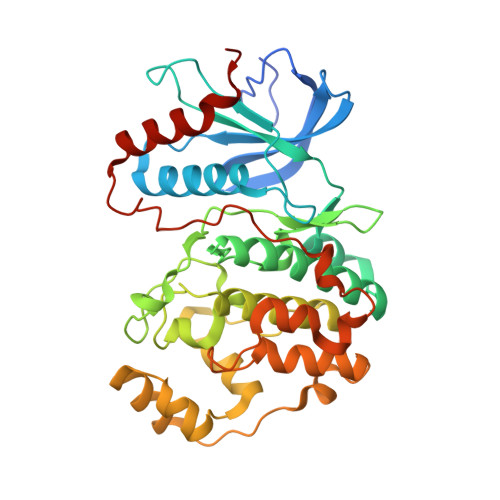Dissecting Therapeutic Resistance to ERK Inhibition.
Jha, S., Morris, E.J., Hruza, A., Mansueto, M.S., Schroeder, G.K., Arbanas, J., McMasters, D., Restaino, C.R., Dayananth, P., Black, S., Elsen, N.L., Mannarino, A., Cooper, A., Fawell, S., Zawel, L., Jayaraman, L., Samatar, A.A.(2016) Mol Cancer Ther 15: 548-559
- PubMed: 26832798
- DOI: https://doi.org/10.1158/1535-7163.MCT-15-0172
- Primary Citation of Related Structures:
5HD4, 5HD7 - PubMed Abstract:
The MAPK pathway is frequently activated in many human cancers, particularly melanomas. A single-nucleotide mutation in BRAF resulting in the substitution of glutamic acid for valine (V(600E)) causes constitutive activation of the downstream MAPK pathway. Selective BRAF and MEK inhibitor therapies have demonstrated remarkable antitumor responses in BRAF(V600) (E)-mutant melanoma patients. However, initial tumor shrinkage is transient and the vast majority of patients develop resistance. We previously reported that SCH772984, an ERK 1/2 inhibitor, effectively suppressed MAPK pathway signaling and cell proliferation in BRAF, MEK, and concurrent BRAF/MEK inhibitor-resistant tumor models. ERK inhibitors are currently being evaluated in clinical trials and, in anticipation of the likelihood of clinical resistance, we sought to prospectively model acquired resistance to SCH772984. Our data show that long-term exposure of cells to SCH772984 leads to acquired resistance, attributable to a mutation of glycine to aspartic acid (G(186D)) in the DFG motif of ERK1. Structural and biophysical studies demonstrated specific defects in SCH772984 binding to mutant ERK. Taken together, these studies describe the interaction of SCH772984 with ERK and identify a novel mechanism of ERK inhibitor resistance through mutation of a single residue within the DFG motif. Mol Cancer Ther; 15(4); 548-59. ©2016 AACR.
Organizational Affiliation:
Early Development and Discovery Sciences, Merck Research Laboratories, Boston, Massachusetts.
















